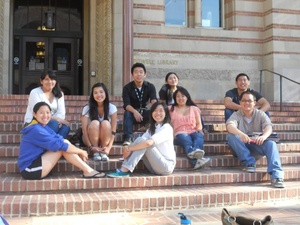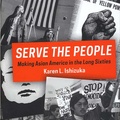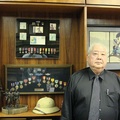As part of the Nikkei Community Internship (NCI) program, I have spent the past eight weeks not only working with the Japanese American Bar Association (JABA) and the Japanese American National Museum (JANM) but also learning more about the non-profit community work being done throughout California’s three Japantowns—Los Angeles’ Little Tokyo, San Jose’s Japantown, and San Francisco’s Nihonmachi. It’s been an eye-opening experience.
I’d like to begin by thanking my supervisor from the Japanese American Bar Association, Alex Fukui, for finding the time outside of a hectic work schedule to help and support me throughout the duration of the internship. In addition, I want to extend thanks to my supervisors at the Japanese American National Museum—Vicky Murakami-Tsuda and Yoko Nishimura—for giving me a home within the museum.
I owe further gratitude to Paul Matsushima, this year’s NCI coordinator, whose down-to-earth personality and overall amazing-ness has made this summer thoroughly enjoyable. And last but certainly not least, thanks to the other interns in this program—particularly those in and around southern California—for making these past few weeks memorable and bright.
In my capacity as an intern with the Japanese American Bar Association, I have interviewed some judges about their distinguished legal careers and turned those interviews into profiles in the form of written articles and oral histories. The four judges who were gracious enough to allow me to interview them were Justice Kathryn Doi Todd, Judge Ernest Hiroshige, Judge Vincent Okamoto, and Judge Jon Mayeda (retired).
On one of my JABA-organized office visits to the Airport Courthouse, a deputy district attorney reminded me that “judges are people, too.” Though they are not exactly revolutionary, these words have stayed with me for a while. It is certainly easy to forget that, behind the weight of those black robes and the gravity of a courtroom, judges are still people; they have their own personalities, their own lived experiences, their own stories to tell.
One of the most memorable anecdotes from my interviews was from my interview with Justice Todd, who fondly recalled the time when she introduced her two-year-old daughter, Mia, to a good friend and neighbor, Judge Robert Higa. Upon meeting him, Mia looked at her mother and said, “I didn’t know men could be judges!” I enjoyed this story because it points to just how remarkable Justice Todd is. After all, in her law school class at Loyola Law School, there were no other Japanese American women. And when Todd began practicing law in Little Tokyo in 1970, she was one of only three Japanese American women lawyers in Los Angeles. For her daughter to have grown up with a mother who was a judge was not common at all at the time.
In addition to juggling the challenges of motherhood with those of judgeship, Justice Todd was instrumental in founding JABA and ultimately paving the way for increased Japanese American representation on the bench. In so many ways, Justice Todd has an incredibly inspiring story to tell, and I feel very lucky that I was able to hear it.
One other thing I will say about Justice Todd’s interview is that she mentioned the centrality of role models to motivation and aspirations, and how she didn’t really have any role models when she was young.
“It’s important for someone to have aspirations in order to get somewhere, and unless there’s something real that you can visualize or aspire to, it’s just not part of your thinking. And I really...I didn’t know any judges. It never occurred to me that that was a possibility,” Todd said. “You know, it was sort of amazing, I thought, that I was even a lawyer. So, [being a judge] was not something that I aspired to. And that’s why it’s important for us to be out there so that young people can say, oh my God, you know, people can do this. You can do all of these things.”
For so many young people today, Justice Todd and people like her provide those much-needed role models to visualize and aspire to. And I am so deeply appreciative of, and inspired by, her for that.
In my interview with Judge Hiroshige, I remember his mention of how important community involvement—particularly in the Asian American community—was for him. Interestingly, I was able to see his tangible contributions in action a few days later, when I saw him in attendance at the Little Tokyo Service Center’s Sake and Tofu fundraiser event. For somebody as busy as Judge Hiroshige to still find the time to come out to events and fundraisers speaks volumes about the level of commitment and dedication to the community.
In my interviews, I kept hearing the same thing about how JABA formed to increase representation on the bench and also to create an institution through which Japanese American jurists could help and support each other. Even in working with various members of JABA, I felt some of that support and help. Before my first interview with Justice Todd, various lawyers in JABA offered help and tips as I was preparing for the interview. Throughout the course of my project, Alex would make sure to check in on my progress and provide helpful feedback on my work constantly. The notion that JABA is an all-volunteer organization run by attorneys who work long hours—and still take the time to do what they feel is important work in the community—is so impressive. The sheer amount of commitment on the part of organizations like JABA continues to impress and inspire me. I’ve felt very fortunate to have had the support and help from JABA that I did as I was working on my projects.
That support has also come from the people at the Japanese American National Museum. Throughout the course of my internship, a temporary cubicle space in the Media Arts Center office of the Japanese American National Museum has been my base of operations. I’ve enjoyed meeting all the staff and volunteers who make the museum a wonderful, comfortable place to work. Furthermore, I’ve thoroughly appreciated the company of Yoko and Vicky, who have made the workplace a fun, light-hearted, and food-centric workplace.
On my first day of work at the museum, Vicky mentioned that the museum is a bad place to lose weight. So true. Every day there’s always someone bringing in food or making s’mores or doing something food-related. And just as frequently, you can find Vicky...taking photos of food. Someone recently brought up the idea of starting a blog that would primarily feature pictures of Vicky taking pictures of food. I hope to see that idea come to fruition in the weeks to come.
One of the more memorable experiences—also food-related—at the museum has been the first sashimi potluck of the summer. I think the most impressive and heartwarming aspect of the sashimi potluck lunch was that it brought all the volunteers and all the staff together. Before that, I don’t think I had ever seen all the people who make the museum what it is, together in one room.
Beyond the time I’ve spent this summer at the Japanese American National Museum, I’ve also had the opportunity to connect with the other interns in the program. It’s been wonderful meeting people who come from so many different places and experiences, and it’s been even more wonderful sharing those experiences with each other.
The NCI-organized site visits to spaces and places throughout the Greater Los Angeles Area have demonstrated how various non-profit and for-profit organizations are dedicating time and resources to helping the Japanese American and larger Asian American communities. From the J. Morey Company, which is and continues to remain heavily invested in the local Little Tokyo community, to the Little Tokyo Service Center, which provides some much-needed services to people in the community (among other things), I have come to realize that there is so much positive good being done here.
Additionally, the intern days and hang-outs have been great experiences to just have fun and find out more about each other and where we come from. The intern days and intern gatherings have offered a safe space and open forum to discuss issues that span the spectrum between personal and professional. Indeed, this internship program is the perfect combination of work and fun.
In a word, the Nikkei Community Internship program has been opportunity—an opportunity to learn the stories of some incredibly accomplished jurists, an opportunity to meet a group of interns who come from all walks of life, and an opportunity to learn more about the wide variety of ways through which community engagement can happen.
A professor of mine used to always tell his students to invest in the people. Initially, I dismissed his words as simply some overused saying that sounded catchy but meant little. I’ve since changed my mind. We must remember our sisters and brothers, and connect with them, if we hope to do things like “build community” and “move forward in solidarity.” I’m still trying to define for myself abstract, vaguely motivating, community-oriented phrases like these, but I do understand that only if we connect to other people—only if we learn their stories and share our own—can we begin to understand ourselves and the people around us a little bit better.
In addition to thinking consciously about judges as people, my experiences in and around Little Tokyo during this internship program have further reminded me of the personal narratives that everyone carries. In a sense, everybody is people, and we would do well to consciously remember that. I hope that I continue to appreciate the amazing stories of all the people I meet.
To borrow even more words that are not mine, the hip-hop lyricist Nas—one of the few good things to come out of the East Coast—once optimistically posited that “the world is yours, the world is yours.” This NCI summer has certainly reinforced my firm belief that the world is indeed ours to go out and change, if we can remember simply to always invest in the people.
*This is one of the projects completed by The Nikkei Community Internship (NCI) Program intern each summer, which the Japanese American Bar Association and the Japanese American National Museum have co-hosted.
© 2012 Lawrence Lan







